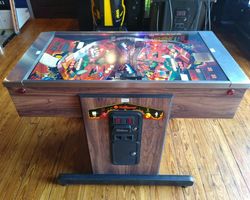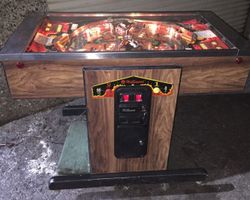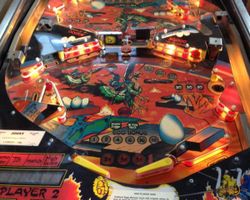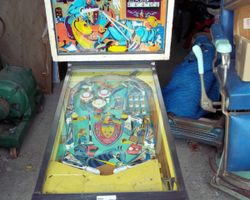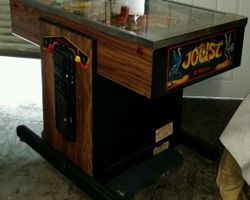Joust
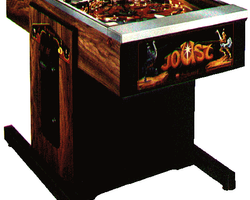
Average Prices: USD $1,500 to $10,900
Produced: April, 1983
Production Run: 402 units
Machine Type: Solid State Electronic
MPU: Williams System 7
Players: 2
Design by: Barry Oursler
Art by: Constantino Mitchell, Jeanine Mitchell
Software by: Cary Kolker
Joust, a pinball machine released by Williams Electronic Games, Inc. in April 1983, stands as a unique entry in pinball history. Its origins trace back to the desire to translate the popular Joust video game, released in 1981, into a pinball format, though the pinball project was initially conceived under the working title 'Conflict'. This endeavor materialized into a distinctive head-to-head pinball experience, a radical departure from the typical single-player design prevalent at the time.
The development of Joust was a collaborative effort involving several skilled individuals. Barry Oursler took the helm as the machine's designer, crafting a playfield tailored for simultaneous, competitive action. The thematic artwork, drawing directly from the video game's world of jousting knights astride flying ostriches, was brought to life by Constantino Mitchell and Jeanine Mitchell, ensuring a visual consistency with its arcade counterpart. John Kotlarik and Tim Murphy were responsible for the sound design, carefully integrating audio cues that echoed the source material. Software development, crucial for managing the complex interplay of two players, was handled by Cary Kolker.
Williams manufactured a limited run of 402 units, making Joust a comparatively rare machine from the System 7 generation. Its release occurred during a challenging period for the pinball industry, between 1983 and 1985, which saw a decline in overall sales. This context likely contributed to its lower production numbers compared to other successful titles. Interestingly, the production run itself saw minor variations, including differences in apron colors (blue/red versus black/red), the shape of the leg ends, and internal component placements such as fuses and post types. These production nuances offer insights into the manufacturing process and iterative refinements made during its limited assembly.
Signature Features and Design
The defining characteristic of the Joust pinball machine is its head-to-head cabinet design, an innovative concept that positions two players at opposite ends of the same playfield. This unique configuration transforms the traditional pinball experience from a solitary endeavor into a direct competition. Each player operates a set of flipper buttons, but critically, these flippers control only those paddles located on the opponent's side of the playfield. This inverted control scheme is central to Joust's appeal and challenge.
Beyond its innovative layout, Joust incorporates several mechanical features essential to its gameplay. The playfield includes two kick-out holes, strategically placed to return balls to play or into scoring opportunities. There are a total of sixteen drop targets, arranged in four sets of 3-bank targets and two sets of 2-in-line targets. These provide primary scoring objectives and open up further playfield features. Two spinning targets add dynamic elements, rewarding precise shots with rapid score accumulation. The game also boasts a 4-ball multiball mode, intensifying the action, and a kickback mechanism to save drained balls, adding a layer of defense. The digital display effectively communicates scores and game information to both players. The visual design, particularly the vibrant artwork, effectively immerses players in the Joust universe, depicting the fantastical aerial combat central to the theme.
Playfield and Mechanics
The Joust playfield is meticulously designed to facilitate its signature head-to-head gameplay. Its layout is largely symmetrical, mirroring the opposing player positions, yet it is simultaneously asymmetrical in its flipper control. Each player stands at one end, facing their opponent across the machine's waist, where the primary playfield features are located. The arrangement necessitates that players aim their shots toward their adversary's "territory," where their flippers are located, while simultaneously anticipating and reacting to balls launched from the other side.
Major shots include the numerous drop targets, which are crucial for scoring and advancing game progression. The four sets of 3-bank drop targets and two sets of 2-in-line drop targets are scattered across the central area, forming defensive barriers and offensive targets. The two spinning targets offer high-scoring opportunities for accurate shots. Kick-out holes are positioned to feed balls back into the action, often leading to rapid exchanges between players. The layout encourages a dynamic flow where balls frequently cross the central divide, forcing both players to remain alert and engaged. The design philosophy centers on continuous interaction and strategic disruption. Players aren't just scoring points for themselves; they are actively interfering with their opponent's game, trying to set them up for difficult saves or quick drains. The artwork on the playfield reinforces the jousting theme, with illustrations of knights and ostriches in mid-flight combat, enhancing the competitive atmosphere. Lighting cues are used effectively to highlight active targets and modes, guiding players through the chaos of simultaneous play.
Gameplay Dynamics
Joust's gameplay dynamics are dominated by its unique head-to-head, simultaneous play. Two players directly compete on the same playfield, with the fundamental twist that each player controls the flippers on their opponent's side. This creates an immediate and compelling strategic layer: success depends not only on one's own shot accuracy but also on understanding how to manipulate the opponent's flippers to their disadvantage. The objective is simple: outscore the opponent within the defined game structure.
Points are accumulated by hitting the various targets and features on the playfield. Dropping the banks of targets, hitting the spinning targets, and making shots into the kick-out holes all contribute to a player's score. The game's flow is characterized by rapid ball exchanges, as a ball launched by one player's flippers quickly becomes a ball the other player must manage with their flippers. This constant back-and-forth demands quick reflexes and foresight.
A distinguishing gameplay mode occurs after both players have drained all their balls. The game transitions into a frantic 30-second "unlimited ball" period for each player. During this time, players can launch an endless number of balls onto the playfield, aiming to maximize their score in a final burst of activity. This mode provides a dramatic crescendo to each player's turn, offering a last chance to gain an advantage. Strategies in Joust often involve aggressive offense, attempting to overwhelm the opponent with balls, coupled with precise defense to prevent easy scores. The true challenge lies in adapting to the inverted flipper control, turning what would normally be a disadvantage into a tool for victory.
Reception and Legacy
Joust has garnered a distinctive reputation within the pinball community, primarily celebrated for its unique and innovative head-to-head gameplay. Feedback consistently highlights the machine as a "blast" and a "must-play," with its two-player experience frequently cited as its greatest strength. The simultaneous competitive action offers an interactive and engaging social experience, setting it apart from the solitary nature of most pinball machines. Players often praise the game for being fun, entertaining, and providing a fresh take on pinball. Its theme, based on the Joust arcade game, resonates strongly with those who grew up with the video game, with sound effects and artwork effectively evoking a sense of nostalgia. The gameplay itself is often described as fast-paced and exciting, demanding a mix of strategy and quick reflexes, making it challenging yet rewarding.
Despite its many strengths, Joust is not without its recognized limitations. The single-player mode, for instance, is generally regarded as less engaging compared to the head-to-head experience. Some players find the rules initially confusing, a common hurdle given the unconventional flipper control and the dual-player dynamics. Its extreme rarity, with only 402 units produced, significantly impacts its accessibility and market value, making it a difficult machine to acquire or even play. While the overall sentiment is overwhelmingly positive, a minority of reviewers suggest that the game's long-term interest might be limited for some, and while the art and sound are fitting, they are not universally lauded as groundbreaking on their own, though they effectively serve the theme.
Despite these minor points, the machine's overall sentiment remains highly positive. Joust's legacy is firmly rooted in its innovative design. It represents a bold experiment by Williams in pushing the boundaries of pinball, venturing into competitive, simultaneous play that was largely unexplored. Its distinctive approach has cemented its place as a memorable and cherished experience, particularly for those who have had the opportunity to engage in a head-to-head match. As such, Joust remains a sought-after machine, not just for its rarity, but for its singular contribution to pinball history and its enduring appeal as a truly unique and interactive game.
Sponsored Links
 Ebay Listings
Ebay Listings
 Auction Results
Auction Results
| Cost | Location | Date |
|---|---|---|
| USD $9,750 |  Connecticut, United States Connecticut, United States |
22 August, 2025 |
| USD $10,000 |  Nevada, United States Nevada, United States |
24 April, 2024 |
| USD $12,000 |  Colorado, United States Colorado, United States |
29 December, 2022 |
| USD $17,995 |  Illinois, United States Illinois, United States |
16 August, 2022 |
| USD $17,500 |  California, United States California, United States |
16 April, 2020 |
| USD $15,000 |  Texas, United States Texas, United States |
19 April, 2019 |
| USD $2,199 |  California, United States California, United States |
13 May, 2018 |
| USD $8,000 |  California, United States California, United States |
27 November, 2016 |
| USD $4,550 |  New York, United States New York, United States |
10 March, 2014 |
| USD $9,000 |  California, United States California, United States |
21 January, 2014 |


Private Policy · Search Website · Contact Us
As an eBay Partner, we may earn a commission from qualifying purchases made through links on this site, at no additional cost to you.
All trademarks and copyrighted materials remain property of their respective owners. All other content copyright 2007 - 2026 Pinpedia.

